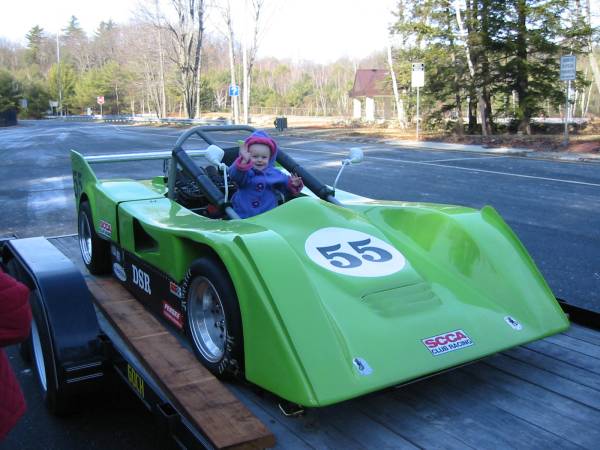
I started looking at the D-Sportsracer class after I bought my Formula Ford in 2001, because I was barred from driving it at a PCA event for "safety reasons," due to its lack of fenders and side impact protection, even though I had driven it at one of their events already. These small, light cars have performance almost equal to the more powerful, open wheeled, Formula Atlantic cars, depending on the course configuration, but have full bodies, which would meet the safety considerations of the Porsche club.
I started frequenting the Sportsracer.net site and browsing their discussion forums. I had always admired the performances of a local autocrosser named Larry Houghton at the local SCCA Solo2 events in his LeGrand sportsracer, and when I saw an ad for one on the "For Sale" forum at Sportsracer.net, I started an email exchange with the seller, David Bedard. He had spent many hours and dollars bringing back a fairly historic example of the Mk. 18 model which had an extensive race history with SCCA. It had begun life on the west coast and had migrated around the country over the years and ended up near Boston, MA. David was very thorough in researching the history of the car, and had assembled these pictures and history of the car, which was featured on pages 5, 6, 7, and 8 of the LeGrand Chassis page at Sportsracer.net.
This went on for several months, and I hesitated about purchasing another car, since I had already bought my WCM Lotus 7 clone for SCCA Solo2 events a year earlier. I eventually met David in San Clemente, CA, when he was on a business trip to Los Angeles, and talked to him extensively about the car, looking over his pictures and documentation of its history and his recent refurbishing project on the car. He was getting anxious to sell the car, as his wife was expecting their second child and he knew he was not going to be able to use it much in the near future, and I felt comfortable enough to make a long-distance deal for the car sight unseen, so we struck a bargain and I had the car shipped out to the west coast, returning it to it's roots after 27 years.
Here it is as it was loaded on the trailer on a winter day in Boston this last December, to be transported across the country to its new home, with David's oldest daughter at the wheel:

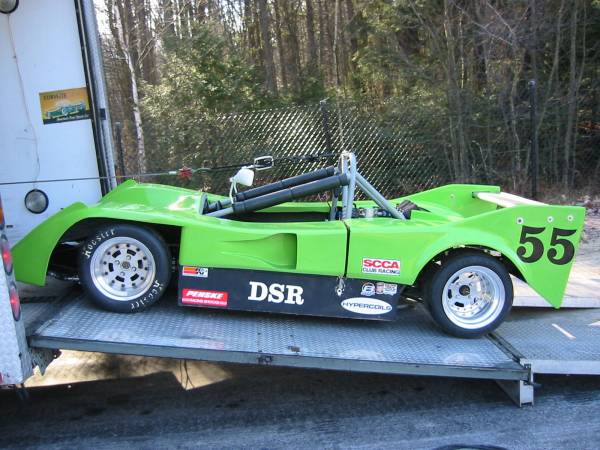
One of my biggest initial concerns about the car was it's small size, since I am a large guy, over 6'3" tall and 220 lbs. or so. I had tried sitting in Larry Houghton's car, and it was a very tight squeeze, as his was the original two-seater configuration with right-hand driving position. One of the best things about this car of David's was that it had been converted to a centerseater in the 80's by one of the previous owners, Hank Thorp. With the removal of the molded FRP seat, and addition of some thin foam pads directly on the aluminum bulkheads, I was relieved to find that I could obtain a very comfortable driving position in the car.
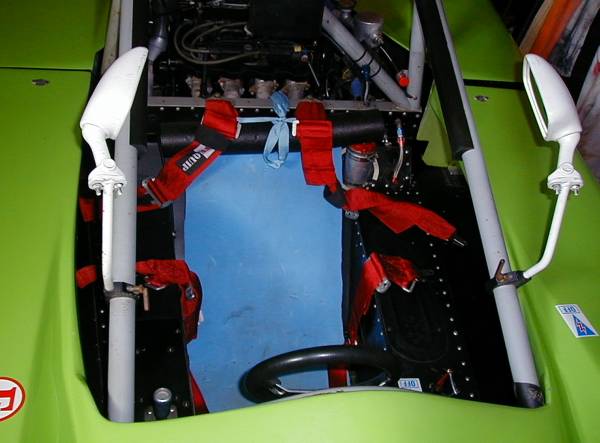
The footbox was very tight, still, and by cutting out some more of the sheetmetal from the top access hole, I was able to work all the pedals perfectly with my big, size 13 feet, although I have to wear thin-soled racing shoes to do it!
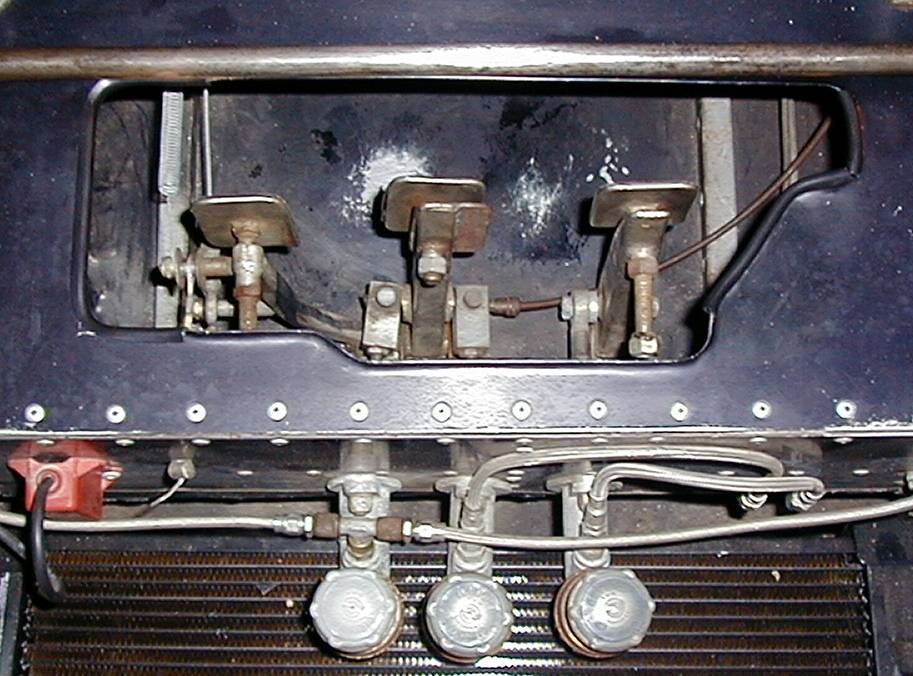
One of the things that Larry had warned me about in using the LeGrand for autox was the need for some re-inforcement on the nose piece, as he had broken the light, fiberglass body by hitting cones on the course. I fabricated a splitter and installed it on the nose to reinforce this area, and hopefully obtain a little downforce on the nose in the process.
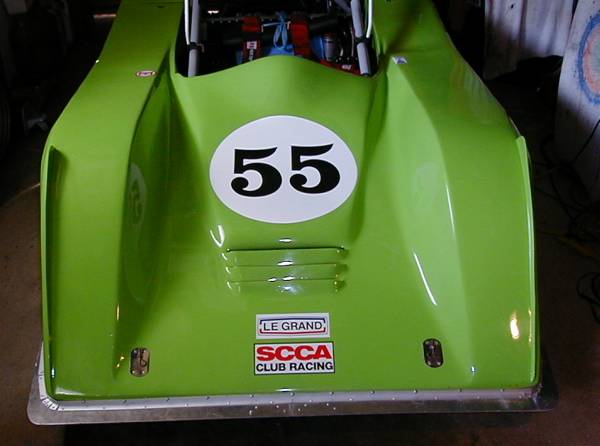
After flushing and bleeding the brake and clutch systems, and refilling and bleeding the cooling system and fuel systems, I started the engine for the first time. It need a choke installed for cold starts, so I fabricated a choke linkage and knob from a generic NAPA kit and installed it on the motor. In the process of checking all the bolts in the drivetrain, I found some problems with the rear axles and CV joints as well as a slight alignment problem with the drive sprockets, but with some custom machining and fabrication work, these were solved. The engine ran a little rough, as the carbs were out of synch and in need of cleaning, so I took the car out to Scrib's Performance in El Cajon and had them remove, clean and tune the carbs. When it came back, it was running smoothly and perfectly. I also added a custom exhaust by Ed Hanson to try to quiet it down so it would pass the sound regs at Qualcomm. The last step was to take it down to Steve Grosekemper at Dieter's, who has done all the setup on my cars, and have the ride height set, with a full alignment and corner balancing done at the same time. With that final prep, I decided it was time to test it on the track. I entered a practice autox at Qualcomm stadium in April with the local SCCA Solo2 group and took my first laps in it at speed (a couple trips around the block for testing purposes in the last few months didn't count!)

I had some overheating problems with the engine while waiting in the pre-grid between runs, since the radiator could do nothing to cool the motor without some airflow. I bought and installed a small, electric SPAL cooling fan on top of the radiator and wired it to a cockpit switch so that it could pull air through it when the car was stationary. I also found that the brake setup had an extreme bias to the rear, and even though I set the cockpit adjustment at "full front," when I started to brake at threshold levels, the rears would still lock first. I started out easily on the first laps to see if anything was going to fall off, and pushed the car a little harder on each succeeding lap when everything went OK. After seven laps, I began to run it up to redline on some of the shifts, and managed to exceed the sound limit of 93 dba for the venue, which brought a warning from the event officials. I had no way to quiet it down, so I just quit for the day.
During the next few weeks, I re-adjusted the plunge rods for the master cylinders to get maximum forward bias out of the balance bars, and added a 2" aluminum silencer to the end of the exhaust pipe to meet the sound regs at Qualcomm. I entered it in a DE event with the Porsche club at the end of the month to see how it would do in continuous lapping.

In the first session, the temps shot up immediately and I pulled off into the pits. My friend and ace mechanic, Steve Grosekemper, was co-driving the car with me, and after a brief pit thrash to bleed the cooling system, we were back on the track.

The car ran fine the rest of the day, and we put 6, 20-25 minute sessions on it, sharing the driving. It out-handled all the Porsches on the short track setup, and we spent most of the time being held up by slower cars, as there was restricted passing on only two straight sections of the track. It could run with any of the cars there that day, including a GT-3 and some purpose-built race Porsche 911s. While the more powerful cars could pull it on the straights, it was always faster in the corners and under braking.
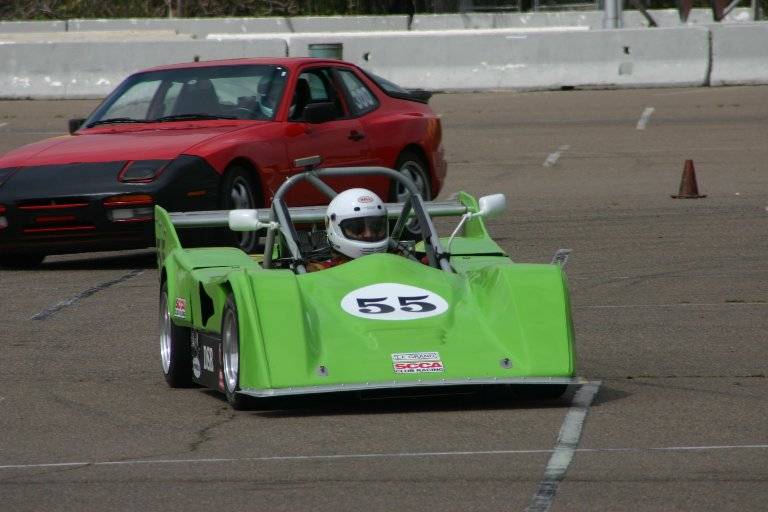
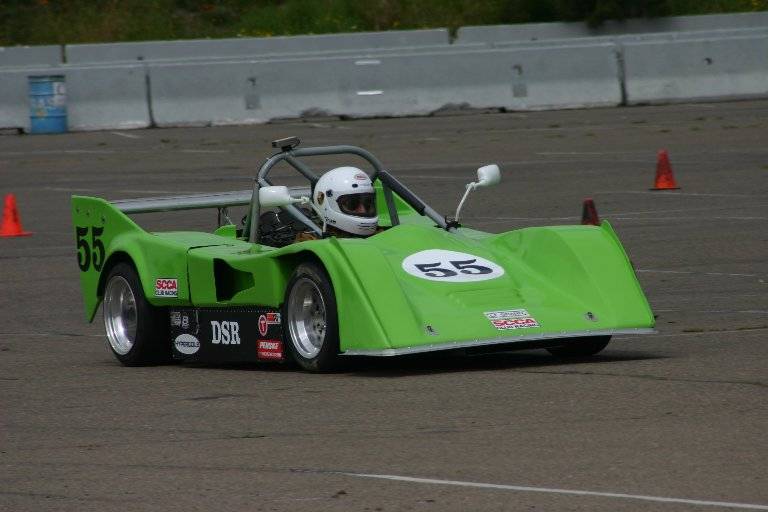
Here's Steve taking his turn in the car.
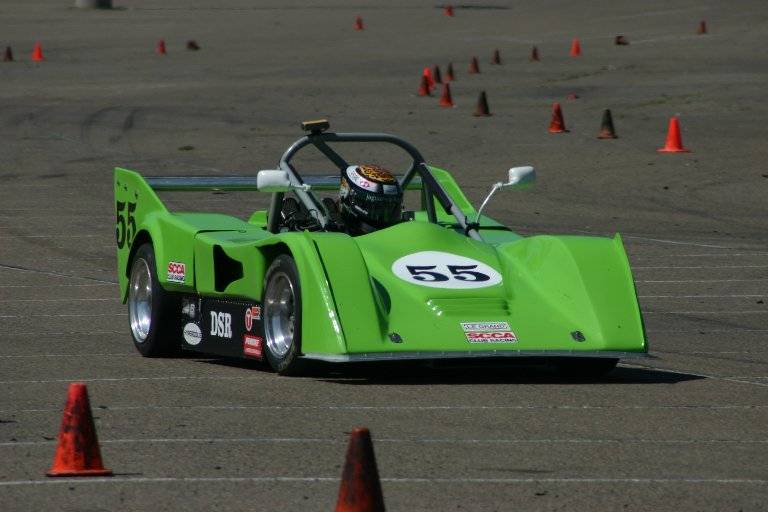
I found it a very physical experience to drive the car hard, with the G-forces in cornering and braking exceeding anything I have experienced in a car to this point. In rushing to get out for the first session, I forgot my neck brace, which helps support the helmet weight, and my kneepads, which keep my kness from getting bruised by the underside of the dashboard, and after 2 sessions of driving, I was pretty beat up and tired. A few minor burns on my arms from the pit thrash to solve the cooling problems didn't help with my comfort level, either. I decided to let my friend Jad Duncan drive the car in my last two sessions, as he has a lot of karting experience and had never driven a race car like this before. After getting familiarized and up to speed, he started turning laps faster than either me or Steve that day! Of course, he is much lighter than I am, and the traffic in the later sessions was not as bad as earlier, since many people had stopped running by then. That's my story, and I'm sticking to it! Here's a pic of Jad in the car coming in from a session.
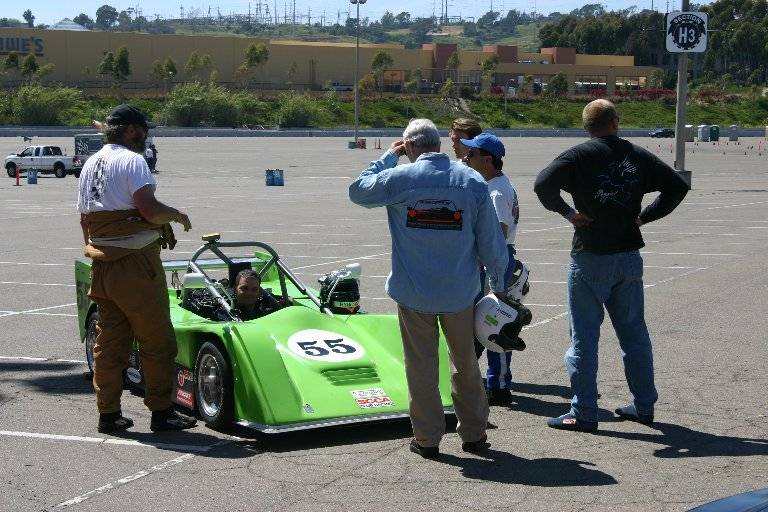
Despite all my adjustments to the brake bias, I found it was still too easy to lock the rears at this event, so care had to be taken in heavy braking, especially when trail braking. Before the next event, I made some modifications to the balance bar setup and plungers at the pedal cluster to improve the front bias, but while it was better, under threshold braking, the rears would still get loose first. I figured that the large, single, inboard Wilwood 4-piston caliper that David had installed in the rear was just too large, compared to the two, 2-piston outboard Lockheed calipers in the front, with smaller rotors. I planned on modifying the master cylinders to send less pressure to the rear brake to alleviate this, but on removing the Girling master cylinders, I realized that one was 5/8" bore and one was 3/4". I simply rebuilt them with new seals and switched their positions, putting the larger cylinder on the rear circuit instead of the front, and lo and behold, at the next event, brake bias could be adjusted to perfection, so that problem was finally solved.
It still wanted to overheat standing in grid, though, so I added an electric booster pump for the coolant circulation, as even with the fan, the mechanical pump on the engine doesn't move enough volume at idle to keep the engine from overheating when stationary, after being driven hard. At the next practice, it was better, but I still used a water sprayer to cool the radiator between runs, and shut it down in between, just restarting to head for the starting line at the latest possible moment. The next plan is to add a second small radiator in the left side pod, which is the original radiator position, since David had converted it to a front radiator earlier. Hopefully, the added heat loss will help keep it cool while standing still and idling up to the line.
I have also removed the existing #55 that came with the car and installed my registered car number, "908" (a nod to the vintage Porsche sportsracer model that it vaguely resembles), as well as installing the rear wing extension sideplates that raise the wing up about 10", to see how that effects downforce.
I have only run the car in SCCA practice events so far, since to be totally legal in B-Mod, the wheelbase needs to be extended 2" from it's existing 78" to the minimum 80" for the class. I could run it as an A-Mod car in Championship events, of course, but it would be hopelessly outclassed by the autox "Specials" in that class. I have become more comfortable driving the car each time, and gotten closer to its limits, but I know an expert (and lighter) driver would still be several seconds faster in it. All in all, the car is the most "bang for the buck" of any race car I have owned, and it is definitely a "keeper." I don't think you could go faster for less $$$. I have sold the WCM Ultralite Lotus 7 clone to make room in the stable for this one, and am already thinking about what other mods might be fun while I'm "in there" doing the chassis lengthening--maybe a Suzuki Hayabusa 1300cc engine and a Taylor/Taggert Quaife diff chain-drive unit??? I could still run it in B-Mod as a CSR, then, and wouldn't be far off the minimum weight, either. HHMMMM....
More to come....
Back to HOME